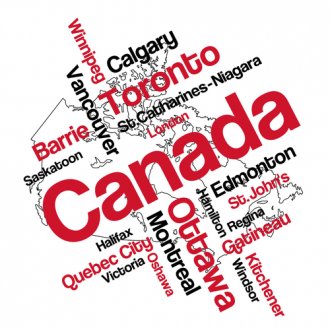
Best Restaurants in Ontario Surrey Canada
 With 10 provinces, three territories and hundreds of cities occupying nearly 10 million square kilometres, choosing where to settle in Canada can be a challenge. For some immigrants, the decision is made easier by relatives who already reside in the country.
With 10 provinces, three territories and hundreds of cities occupying nearly 10 million square kilometres, choosing where to settle in Canada can be a challenge. For some immigrants, the decision is made easier by relatives who already reside in the country.
“My sister lives in Toronto so when I moved it was natural for me to want to be close to her, ” says Lorriannys Ramirez, originally from Venezuela. “It would have been hard to live all the way on the other side of the country, knowing no one; here it felt a little bit more like home.”
Other newcomers base their choice on climate. Jayson Singh’s quest for a city he could call home ended after he performed an online search for Canada’s hottest spots.
“Coming from Trinidad, I’m used to sun and warm weather all the time, ” laughs Singh, who lives in Vancouver. “I heard that in some Canadian cities, like Calgary and Edmonton, it gets cold, below freezing. I figured I should move to the mildest climate possible so it wouldn’t be such a shock.”
Another factor that can potentially influence new immigrants’ settlement decisions is the ethnocultural pockets that exist from coast to coast. Manitoba, for instance, possesses the largest Icelandic population in Canada; in fact, the Rural Municipality of Gimli, about 75 kilometres north of Winnipeg, is home to more people of Icelandic ancestry than anywhere else in the world — outside of Iceland, of course.
“It may be easier for people to go where more neighbours and businesses in the area will likely speak their language, ” confirms settlement worker Mandy Tam. “But some immigrants really want to live in a community that pushes them out of their comfort zone. They want to practise English and immerse themselves in Canadian culture.”
If you don’t have any strong familial ties or hang-ups about the weather, taking a look at local job markets, home prices and other costs of living across Canada can help you make the best decision when it comes to your settlement.
LOWER MAINLAND, B.C.
Voted the most livable city in the world almost every year for the past decade, Vancouver, with more than 603, 000 residents, is the eighth-largest city in Canada. When combined with adjacent areas (Burnaby, Richmond and Surrey, to name a few) that make up Metro Vancouver, the population swells to more than 2.3 million people. Residents enjoy a rather temperate climate (compared with the rest of Canada) that allows them to participate in a wide range of outdoor activities throughout the year.
> Industries/jobs: These vary from finance and tourism to trade, transport, education, manufacturing and more. Many global mining operations are headquartered in Vancouver, plus video-game makers and animation studios. The city is a base for nearly three-quarters of B.C.’s 6, 000 information- and communications-technology firms and, thanks to its proximity to the Pacific Rim, has strong ties to Asian markets.
> Housing: Situated by snow-capped mountains and sparkling waters, the Lower Mainland certainly is beautiful — but these perks come at a price. A single-family home in the City of Vancouver can cost between $400, 000 and $4 million, depending on the neighbourhood. Housing prices tend to drop as one moves further from the core, particularly to suburbs like Surrey, but even then many homebuyers can only afford condos or townhouses.
> Cost of living: A recent cost-of-living survey that took housing, transportation, food, clothing, household goods and entertainment (among other) costs into account on an annual basis placed Vancouver among the three most expensive cities in North America.
|
Average Household Expenses in B.C. |
|
| Food | $8, 073 |
| Shelter | $16, 495 |
| Household operation | $4, 377 |
| Household furnishings and equipment | $1, 963 |
| Clothing and accessories | $3, 158 |
| Transportation | $10, 980 |
| Health care | $2, 511 |
| Personal care | $1, 113 |
| Recreation | $3, 987 |
| Education | $1, 411 |
| Income taxes | $11, 486 |
| Personal insurance payments and pension contributions | $3, 758 |
(Source: Statistics Canada, Average Household Expenditure, B.C., 2011)
THE INTERIOR, B.C.
The south-central and southeast portions of B.C. go by various names (Interior, Kootenays and Thompson Okanagan, as examples) and include cities like Nelson, Kamloops, Kelowna and Penticton.
> Industries/jobs: With fertile valleys and world-famous ski resorts, agriculture and tourism figure among the main industries in the areas. The other major sector players are mining and resources. In the Kootenay region, coal and metal ores have been economic anchors for generations while forestry reigns in the Thompson Okanagan. Currently the top industry in both areas, however, is construction, with more than 4, 000 construction companies operating in this region. Last July, the B.C. government announced that the province’s Interior experienced record-breaking job growth, mainly in the forestry, mining and natural-gas industries, as well as in service sectors.
> Housing: In February 2013, the South Okanagan Real Estate Board reported that the average selling price of a single-family residential home in that part of B.C. sold for $287, 520.
> Cost of living: Compared to Vancouver, the cost of living is considerably less as you move eastward, especially when it comes to housing. Other costs such as food and fuel vary depending on community, but aren’t drastically different from the Lower Mainland.
CALGARY, ALBERTA
The largest city in the province of Alberta is home to nearly 1.1 million people. With fresh air, open spaces, park land, rivers, mountains and more days of sunshine than any other major Canadian metropolis, Calgary is a beautiful place to call home. The city is rich in the arts, culture, entertainment and leisure activities and venues, and boasts the most extensive urban pathway and bikeway system in North America.
> Industries/jobs: The energy industry is king here, with one out of every 13 jobs in Alberta directly related to oil and gas, putting engineers, geologists and mineral technologists in high demand. In fact, the province’s resources account for the third-largest reserves of crude in the world and the largest deposits of oil sands globally. As such, international companies are investing billions of dollars into this sector and Calgary houses the headquarters of major Canadian and global energy companies.
> Housing: A standard two-storey house in Calgary costs an average of $431, 500.
> Cost of living: The cost to live in Calgary — not as high as some other parts of Canada — becomes even more manageable when Alberta’s low provincial taxes are taken into account. Personal income taxes and inheritance taxes, for example, are among the lowest in the country. Additionally, Alberta is the only province without any sales tax.
|
Average Household Expenses in Alberta |
|
| $8, 512 | |
| $18, 300 | |
| $4, 585 | |
| $2, 268 | |
| $3, 926 | |
| $13, 465 | |
| $2, 257 | |
| $1, 147 | |

















